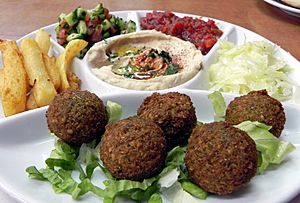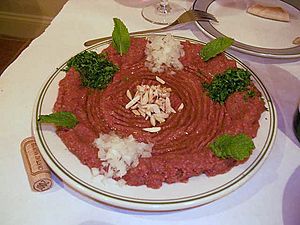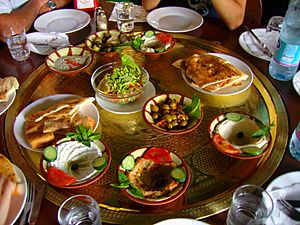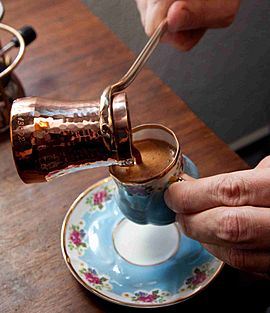Middle Eastern cuisine facts for kids
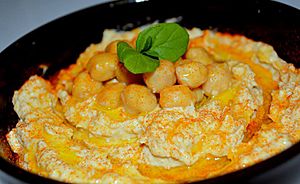
Middle Eastern cuisine is the delicious food from countries in West Asia. This includes food from Arab, Armenian, Assyrian, Azerbaijani, Cypriot, Egyptian, Georgian, Iranian, Iraqi, Israeli, Kurdish, Lebanese, Palestinian, and Turkish cultures.
Some common ingredients you'll find are olives and olive oil, pita bread, honey, sesame seeds, dates, sumac, chickpeas, mint, rice, and parsley. Popular dishes include kebabs, dolmas, falafel, baklava, yogurt, doner kebab, shawarma, and mulukhiyah.
Contents
Where is Middle Eastern Food From?
It can be tricky to say exactly which countries are part of the Middle East. The definition has changed over time. Today, the Middle East usually includes: Bahrain, Cyprus, Egypt, Iran, Iraq, Israel, Jordan, Kuwait, Palestine, Lebanon, Oman, Qatar, Saudi Arabia, Syria, Turkey, United Arab Emirates, and Yemen.
Middle Eastern cuisine also includes dishes from many cultures. These are Arab, Armenian, Assyrian, Azerbaijani, Cypriot, Georgian, Iranian, Israeli, Kurdish, Levantine, and Turkish foods.
Different Kinds of Middle Eastern Food
Food from the Fertile Crescent
Arab Cuisine Styles
Southern Caucasus Food
Other Middle Eastern Cuisines
How Middle Eastern Food Developed

The Middle East is where many important foods first grew. This includes the Fertile Crescent, where wheat was first farmed. Later, rye, barley, lentils, beans, pistachios, figs, pomegranates, and dates also became common.
Animals like sheep, goats, and cattle were also first raised here. People in this region also discovered how to ferment food. This helped them make bread rise and brew beer. Some of the oldest written recipes come from this area.
The Middle East is a crossroads between Europe, Asia, the Caucasus, and North Africa. This made it a place where food and recipes were often shared. During the first Persian Empire (around 550–330 BCE), new foods like rice, poultry, and fruits became part of the local diet. Merchants brought figs, dates, and nuts to new lands. Spices also arrived from the East.
The food was also influenced by dumplings from Mongol invaders. Turmeric and other spices came from India. Cloves, peppercorns, and allspice arrived from the Spice Islands. Okra came from Africa, and tomatoes from the New World.
Religion has also shaped the cuisine. Both Jewish and Muslim people do not eat pork. Because of this, lamb is the main meat eaten.
Under the Ottoman Empire, sweet pastries made from thin phyllo dough became popular. Thick Turkish coffee was also introduced to the region.
Key Ingredients and Dishes
Grains: The Base of Meals
Grains are very important in Middle Eastern food. Wheat and rice are staple foods, meaning they are eaten almost every day. Barley is also widely used. Corn has become common in some areas too. Bread is a universal food, eaten by everyone at nearly every meal.
Besides bread, wheat is used to make burghul and couscous. Burghul is wheat that has been partly cooked, dried, and broken into pieces. It is often cooked like rice.
Burghul is also used in meat pies and salads. A famous salad is tabbouleh, made with chopped parsley, tomato, lemon, and oil. Freekeh is another common grain, made from young green wheat.
Many types of rice are grown and eaten. Plain rice is served with grilled meats or in stews with meat and vegetables. More complex rice dishes can have layers of meat, vegetables, sauces, nuts, or dried fruits.
Flavorings: Spices and Oils
Butter and clarified butter (also called smen or ghee) are traditionally used for cooking. Olive oil is common in areas near the Mediterranean Sea. Christians use it during fasts when meat and dairy are not allowed. Jewish people use it instead of animal fats to avoid mixing meat and dairy.
Most Middle Eastern regions use many spices. A typical stew might have a little cinnamon, nutmeg, cloves, cumin, and coriander. Black pepper is popular. Chili peppers are sometimes used, especially in sauces or as pickles. Parsley and mint are widely used in cooking and salads.
Thyme and thyme mixes (like za'atar) are common in Syria, Egypt, Lebanon, Jordan, Palestine, and Israel. Za'atar is often a mix of dried thyme and sumac (sour berries). It is eaten for breakfast with oil and bread. Sumac is also sprinkled over grilled meat. Garlic is used a lot in many dishes and salads.
Religious Influences on Meat
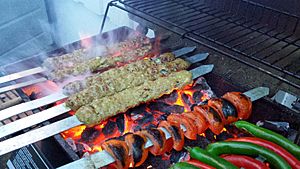
Lamb and mutton are favorite meats. This is because pork is not allowed by both Islamic and Jewish dietary laws.
Grilled meats, called kebabs, are very popular. There are many types. The most popular is cubed lamb on skewers, known as shish kebab. Chicken can also be grilled this way. Another popular type is kofta kebab. This is made from ground meat mixed with onions and spices. It's shaped around a skewer like a sausage and grilled. Kebabs are often street food or restaurant food. They are served with bread, salad, and pickles. They are usually not made at home.
Stews with meat and vegetables are served with rice, bulgur, or bread. Kibbeh is a pie or dumpling made with meat and grain.
The most popular kibbeh is made with ground meat (usually lamb) and burghul. This mix is shaped into a dough and stuffed with fried minced meat, onion, herbs, and sometimes pine nuts or almonds and raisins. It can be made into small, torpedo-shaped dumplings or baked like a cake in a tray.
Another type of kibbeh is kibbeh naye. This is made by pounding raw meat and burghul with seasonings. It is served with lemon juice and chili sauce for dipping.
Vegetables and Legumes

Vegetables and pulses (like beans and lentils) are staple foods. They are boiled, stewed, grilled, stuffed, and cooked with meat and rice. Leafy vegetables include many kinds of cabbage, spinach, and chard. Root vegetables like onions, garlic, carrots, turnips, and beets are also popular.
Squash, tomato, eggplant, and okra are special parts of the region's food. Eggplant is often sliced, fried, and served with yogurt and garlic. Baba ghanoush is roasted eggplant that is mashed and mixed with tahini (sesame paste), lemon juice, garlic, and cumin.
Tomato is used everywhere in Middle Eastern cooking. It's used fresh in salads, cooked in stews, and grilled with kebab.
Beans and pulses are very important, second only to grains. Fava beans are eaten both fresh and dried. Dried fava beans are boiled to make ful medames. This is one of the most popular Egyptian home and street foods. Mashed fava beans are served with oil, lemon, and chili. Similar dishes are found across the region.
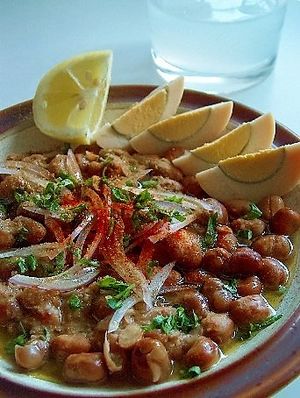
Falafel, popular in Europe and the United States, was first made from dried fava beans. These were shaped into a rissole with herbs and spices and then fried. It is also made from chickpeas, or a mix of both. Green fava beans are cooked like other green beans, boiled with oil or stewed with meat. Green beans and black-eyed peas are also well-known.
Lentils, split peas, and chickpeas are widely used in soups and salads, often with rice or meat. Hummus, made from chickpeas and tahini, started in Syria and Lebanon.
Popular Dishes to Try
Stuffed vegetables are a classic Middle Eastern dish. They are often called dolma (Turkish for "stuffed") or mahshi. Grape leaves, chard, and cabbage are stuffed with rice, ground meat, pine nuts, and spices. They are then stewed in oil and tomatoes. Many other vegetables like squash, onion, tomato, eggplant, peppers, and carrots are also stuffed and stewed or baked.
Meze is popular across the Middle East. It's a collection of small dishes. These can include cheese, melon, nuts, salads, and dips like tabbouleh, hummus, and mutabbal. Pickles are also common. More filling items like grilled meat, kibbeh, and sausage can also be part of meze.
Middle Eastern people often drink milk, either fresh or soured. Yogurt is commonly eaten plain, used in cooking, or mixed into salad dressing. It can also be diluted to make a drink. Greek feta and halloumi are the most popular cheeses in the region.
Drinks of the Middle East
Turkish coffee is famous around the world. It is thicker than other coffees. It's made by boiling very finely ground coffee in water and letting the grounds settle. In the 1980s, instant coffee also became popular.
Arak is a strong, anise-flavored alcoholic drink. It is usually mixed with water and ice. It's often served at social gatherings with meze.
Some Christians, like the Assyrians, Armenians, Cypriots, and Maronites, make their own beer and wine.
Qamar al-Din is a thick, sweet apricot drink. Muslims drink it during Ramadan. Apricots are boiled with sugar and water until thick, then sun-dried. The dried fruit is then mixed with water and sugar.
Jallab is a fruit syrup made from grape molasses, dates, and rose water. It's served over crushed ice, sometimes with raisins or pine nuts.
Doogh (or ayran) is a salty, yogurt-based drink. It is popular in Turkey and Iran.
Dining Customs
Eating in Arab Countries
In some Arab countries, especially around the Persian Gulf region, people often eat from a large shared plate in the middle of the table. They traditionally don't use forks or spoons. Instead, they scoop up food with pita bread or with their thumb and two fingers.
In Arabic culture, the left hand is considered unclean. Even left-handed people eat with their right hand. However, the left hand can hold a drinking glass when eating greasy food with the right hand.
It is polite to praise the host for their food and kindness. You should also try a little bit of every dish on the table. If a guest leaves no food on their plate, the host will usually fill it up again right away.
Ramadan: A Special Time for Food
During Ramadan, Muslims fast from sunrise to sunset. Food consumption increases a lot in Muslim communities during this month. Breaking the daily fast is a big meal with family and friends. Public meals are also held by charities.
Cafes and pastry shops stay open at night. The streets feel like a party. Many Muslims break their fast with a date, following the example of Muhammad. Then they eat many different dishes. Sweet pastries and puddings are always part of Ramadan nights.
The end of Ramadan is celebrated with Eid al-Fitr. This holiday features a huge amount and variety of sweets and pastries.
The other major Muslim holiday is the four-day Eid al-Adha, the Feast of the Sacrifice. This happens during Dhu al-Hijjah (the pilgrimage month). A sheep or goat is usually sacrificed in homes that can afford it. Big feasts are prepared, and food is given to those in need.
Eating in Turkey
Tea is usually served in curved glasses. You hold them by the rim. Water can be added to the tea. A cup of tea can be refilled if it's less than half full. An honored guest is expected to make a toast, usually after the host or at the end of the meal.
Forks, spoons, and knives are used. Sometimes, the knife is held in the right hand and the fork in the left, like in British style. Smoking might be okay between courses of a dinner.
In formal situations, the hosts sit at the head of the table. The honored guest sits next to them, on the side farthest from the door.
The honored guest is served first. Then, it's polite to serve older guests before younger ones, and men before women. Diners do not start eating until the oldest person at the table begins.
In some casual restaurants, dishes are ordered when you want them, not all at once. At casual restaurants, you might share a table, but you don't have to talk to others.
Guests might need to take off their shoes. It's polite to say Afiyet olsun ("May what you eat bring well-being") before or after eating. After a meal, you can say Elinize sağlik ("Bless your hand") to the person who cooked the meal.
Eating in Iran
Iranian dishes are known for being rice-based. Iran has a long history of growing rice. Dishes are usually served as savory or sweet, not in separate courses.
In traditional Iranian restaurants, meals are served on a large, low table. This table is covered with Persian rugs and has cushions around it. Diners sit cross-legged in a circle. Food is served in the center and eaten with cutlery on separate plates. Tea is served in kamar baareek ("narrow-waist") glasses with sugar and Persian sweets.
When guests are invited for dinner at home, it's considered rude to make just enough food. So, large amounts of food are prepared. An important Persian custom is taarof (ritual politeness). If someone offers you food or a drink, you might politely decline at first. You only accept after the host has offered several times. This is to avoid looking greedy.
Middle Eastern Food Around the World
In 2017, Middle Eastern cuisine was one of the most popular and fastest-growing ethnic foods in the US. Dishes like hummus and falafel are becoming more and more common in restaurants across the United States.
Sometimes, Middle Eastern food is mistakenly thought to be the same as Mediterranean food in Western countries.
See also
 In Spanish: Gastronomía de Oriente Medio para niños
In Spanish: Gastronomía de Oriente Medio para niños


